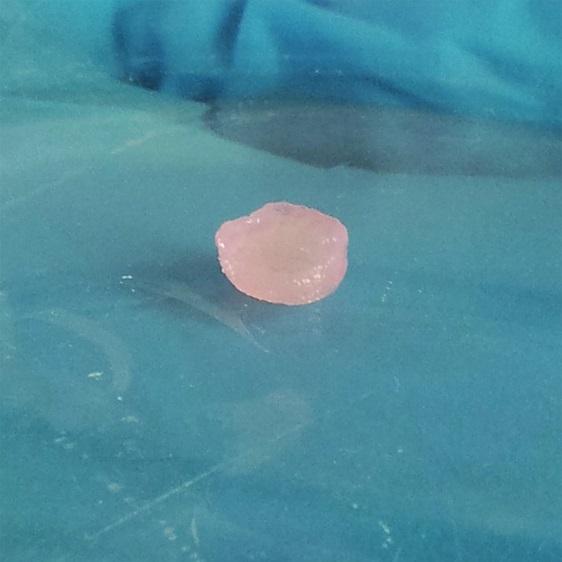Cells from cow knee joints used to grow new cartilage tissue in laboratory

Engineered cartilage tissue at Umeå University. Credit: Janne Ylärinne
Articular cartilage is tissue that is found on all the joint surfaces in the body. Since the tissue is not supplied with any blood vessels, it has a low self-repair capacity. Joint injuries and wear often damage cartilage tissue, leading to a condition called osteoarthritis.
In 2012 in Sweden, 26.6 percent of all people age 45 years or older were diagnosed with osteoarthritis. In serious cases, osteoarthritis can mean the loss of practically the entire cartilage tissue in the joint. While the condition causes pain and immobility for the individual, it also burdens society with accumulated medical costs.
“There is currently no good cure for osteoarthritis,” says Janne Ylärinne, doctoral student at the Department of Integrative Medical Biology and author of the doctoral dissertation.
“Surgical treatments may help when the damage to the cartilage is relatively minor, whereas joint replacement surgery is the only available solution for people with larger cartilage damage. However, artificial joints only last for a couple of decades, making the surgery unsuitable for young persons. So we need a more permanent solution.”
Tissue engineering provides a possible solution to osteoarthritis. In their experiments, the researchers at Umeå University made findings that provide useful information for efforts to develop new methods to produce cartilage-like “neotissues” in a laboratory environment.
In the engineering process, the cells, the signaling molecules and the scaffold, i.e. artificial support material, are combined to regenerate tissue at the damaged site in the joint.
The process is difficult and much of what constitutes suitable growth factors and a mechanical loading environment is still unknown. Today, there is a huge variety of available synthetic and natural scaffolds. It is also unclear whether stem cells or primary cells are best suited.
Using primary bovine chondrocytes, i.e. cartilage cells from cows, the researchers improved methods to grow cartilage tissue in a laboratory environment, producing tissue similar to tissue normally present in the human joints. In future, these results may help the development of neocartilage production for actual cartilage repair.
For this, stem cells could be grown to provide unlimited amount of material for tissue engineering. However, more research is needed to improve the tissue quality and make it more structurally similar to the hyaline cartilage found in the human body.
###
Janne Ylärinne comes from Sonkajärvi in Finland.
Media Contact
All latest news from the category: Health and Medicine
This subject area encompasses research and studies in the field of human medicine.
Among the wide-ranging list of topics covered here are anesthesiology, anatomy, surgery, human genetics, hygiene and environmental medicine, internal medicine, neurology, pharmacology, physiology, urology and dental medicine.
Newest articles

First-of-its-kind study uses remote sensing to monitor plastic debris in rivers and lakes
Remote sensing creates a cost-effective solution to monitoring plastic pollution. A first-of-its-kind study from researchers at the University of Minnesota Twin Cities shows how remote sensing can help monitor and…

Laser-based artificial neuron mimics nerve cell functions at lightning speed
With a processing speed a billion times faster than nature, chip-based laser neuron could help advance AI tasks such as pattern recognition and sequence prediction. Researchers have developed a laser-based…

Optimising the processing of plastic waste
Just one look in the yellow bin reveals a colourful jumble of different types of plastic. However, the purer and more uniform plastic waste is, the easier it is to…



